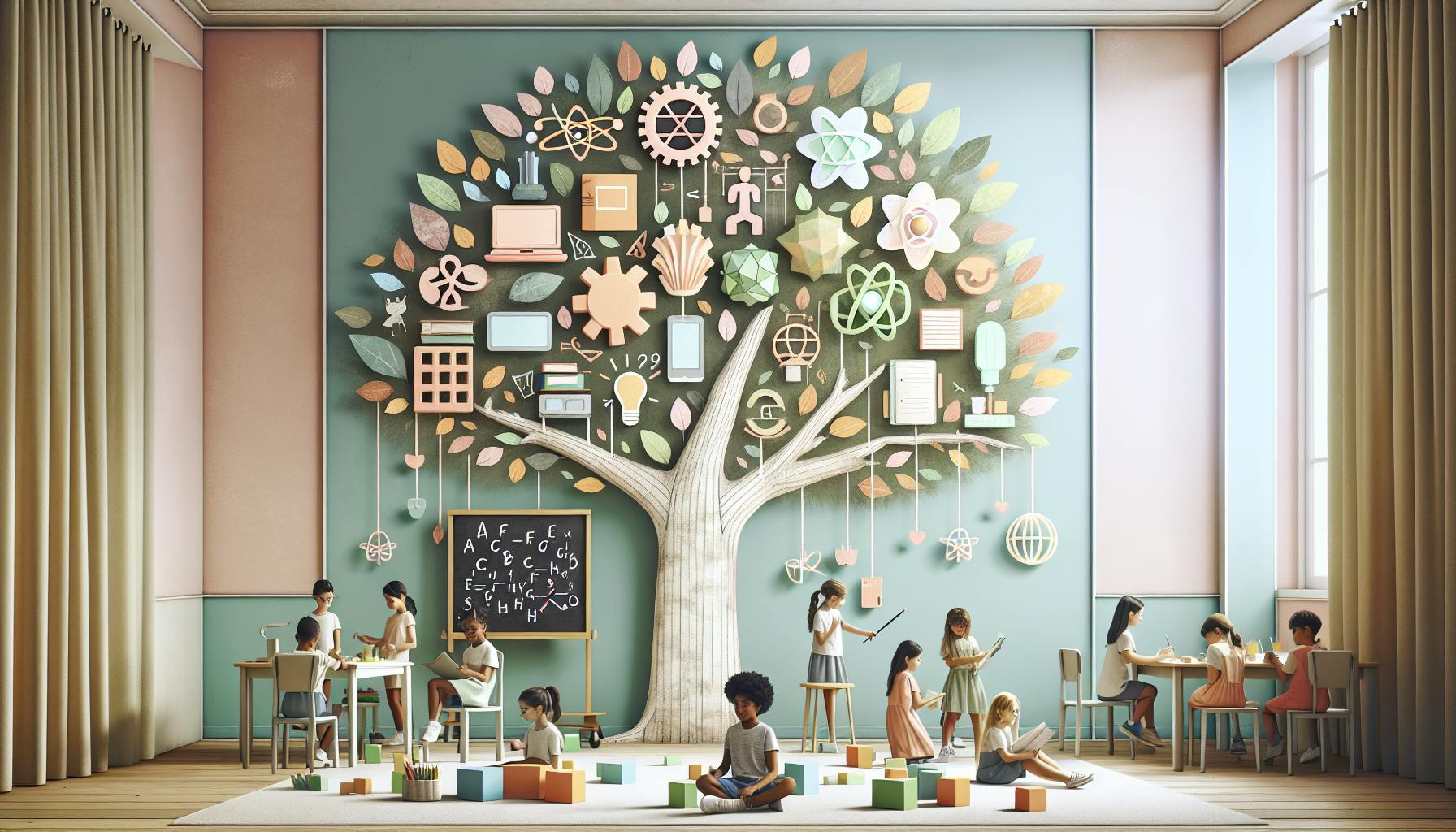Flipped classrooms turn traditional teaching on its head:
- Students learn new content at home through videos or readings
- Class time is used for hands-on activities and problem-solving
- Teachers become guides rather than lecturers
Key benefits:
- Students learn at their own pace
- More time for active learning in class
- Increased student engagement
- Video creation: ScreenPal, Snagit, Camtasia Studio
- Interactive content: Edpuzzle, Kahoot!, Quizizz
- Assessment: Google Forms, Edulastic
Real-world examples show improved results across subjects:
- Math and science: More time for labs and problem-solving
- English and history: Deeper discussions and analysis
- Languages: Increased speaking practice
Effective flipped classrooms require:
- Engaging pre-class content
- Well-designed in-class activities
- Regular assessment of student learning
Potential downsides:
- Increased out-of-class workload
- Technology access issues
- Group work stress for some students
| Traditional Classroom | Flipped Classroom |
|---|---|
| Teacher lectures in class | Students review content at home |
| Homework for practice | Active learning in class |
| One-size-fits-all pace | Students learn at own speed |
| Teacher-centered | Student-centered |
Flipped classrooms can boost engagement and academic performance when implemented thoughtfully.
Tools for Flipped Classrooms
The right tools can make your flipped classroom a success. Let's look at some software and platforms that'll help you run your flipped classroom like a pro.
LessonBud: AI Tools for Teachers

LessonBud is the first AI-powered tool made just for teachers. It cuts down on busywork so you can focus on teaching.
Here's what LessonBud does:
- Creates homework quickly
- Tracks student progress easily
- Works with your current teaching setup
- Doesn't cost an arm and a leg
- Helps with lesson planning and talking to parents
It's like having a super-smart teaching assistant right at your fingertips.
Making and Managing Videos
Videos are key in flipped classrooms. Here are some great tools for creating and managing your video lessons:
| Tool | What It Does | Best For |
|---|---|---|
| ScreenPal | Records your screen and webcam, 15-min free videos | Quick how-tos |
| Snagit | Captures scrolling screens, easy to share | Detailed step-by-steps |
| Camtasia Studio | Multi-track timelines, makes quizzes | Pro-level video editing |
| Edpuzzle | Makes videos interactive, adds questions | Getting students involved |
Pro tip: Get a good mic like the Snowball USB. Texas Tech University found that bad audio can kill student interest fast.
Want to up your video game? Use two cameras. It's great for showing different views during your lessons. Try the Mevo Start for live streaming and the Logitech C270HD webcam for clear shots of you and your whiteboard.
Testing and Quiz Tools
Checking what students know is crucial in flipped classrooms. These tools make it easy:
1. Kahoot!
This game-like platform has quizzes, surveys, and discussions. Students actually get excited about answering questions!
2. Quizizz
Another free quiz tool that works with Google Classroom. You can give quizzes as homework, and it even throws in funny memes.
3. Google Forms
An old favorite that now lets you make quizzes with answer keys and feedback. It shows you color-coded data to quickly spot where students might be struggling.
4. Edulastic
This platform has over 38,000 questions and lets you make as many quizzes as you want for free. It's great for finding gaps in learning and getting ready for big tests.
Real Examples of Flipped Classrooms
Flipped classrooms are shaking up education across the board. Let's dive into how teachers are using this approach to supercharge learning in different subjects.
Math and Science Classes
In math and science, flipped classrooms are helping students crack tough concepts.
Jessica Verrill, a high school chemistry teacher in Maine, flipped her classroom during a hybrid schedule. The results?
- Students could hit pause and rewatch demos
- Class time became a lab playground
- Jessica could guide students without feeling rushed
"Flipping let me create a more engaging learning environment", Jessica said.
Keri Tafuro, a middle school math teacher in California, saw her 7th and 8th grade classes take off after flipping:
- She snagged a teacher of the year nomination
- Students loved learning through her videos
- One kid even said: "Mrs. Tafuro, I wish I could pause or rewind you right now!"
English and History Classes
For subjects that thrive on discussion, flipped classrooms are opening new doors.
History teachers are tapping into content from History.com and PBS.org. Here's the game plan:
Students watch videos or read at home. Then, class time turns into:
- Heated debates (like "Could Napoleon have won the Peninsular Campaign?")
- Group discussions that get everyone talking
- Deep dives into historical documents
In English classes, the flipped model cranks up the volume on text analysis and writing workshops.
Language Classes
Language learning gets a turbo boost from flipped classrooms:
Students tackle vocab and grammar at home through videos. Class time? It's all about speaking practice and interactive exercises.
This approach:
- Cranks up exposure to the target language
- Tailors learning to each student
- Gives students the guts to speak up in class
Greg Green, Principal at Clintondale High School, flipped classrooms across all subjects. Check out these jaw-dropping results:
| Subject | Failure Rate Drop |
|---|---|
| English | 33% |
| Math | 31% |
| Science | 22% |
| Social Studies | 19% |
"I'm convinced this model can redefine how we deliver education", Greg said.
Flipped classrooms aren't just a trend - they're transforming how students learn, one video at a time.
Making the Most of Class Time
Flipping your classroom opens up new ways to engage students. Let's look at how to use this extra time effectively.
Group Work and Problem Solving
With lectures now homework, class time becomes a hub for teamwork. Here's how to set up group activities:
Case Studies: Split students into small teams to tackle real problems. In a business class, they might analyze Airbnb's success, using concepts from their at-home learning.
Think-Pair-Share: Ask a thought-provoking question. Give students time to think, then discuss with a partner before sharing with the class.
Guided Inquiry: Present a complex problem and guide students to find a solution. This builds critical thinking skills and deepens subject understanding.
Eric Mazur, a Harvard physics professor, says his flipped classroom "resembles a kindergarten class with its active engagement and structured chaos. Learning happens through participation, not passive listening."
Students Teaching Students
Peer teaching is a powerful tool. It helps both the "teacher" and the "student" learn better. Try these methods:
Jigsaw Method: Assign different topics to small groups. Each group becomes "experts" and teaches their topic to the class.
Presentation Rotations: Have students create short presentations on specific topics. Rotate through these mini-lessons, with students leading discussions.
Peer Tutoring: Pair up students with different strengths to help each other. This reinforces learning and builds communication skills.
A University of Washington study found that students in active learning classrooms scored 6% higher on exams compared to those in traditional lectures. Peer teaching was a big part of this improvement.
Practice and Projects
Class time is perfect for hands-on work and real-world projects. Here's how to make it happen:
| Activity | Description | Benefits |
|---|---|---|
| Lab Work | Students do experiments or solve problems related to lecture material | Applies theory to practice |
| Project-Based Learning | Long-term projects tackling complex questions | Builds research and teamwork skills |
| Role-Playing | Students act out scenarios related to the subject | Enhances understanding through experience |
| Debates | Structured arguments on controversial topics | Improves critical thinking and speaking skills |
Jessica Verrill, a high school chemistry teacher in Maine, found that flipping her classroom allowed for more lab time. "Students can pause and rewatch demos at home, leaving class time for hands-on experiments", she explains. "It's created a more engaging learning environment."
sbb-itb-bb2be89
Better Homework Design
In a flipped classroom, homework isn't about solving problems after school. It's the foundation for in-class activities. Let's look at how to create homework that preps students for active learning.
Getting Ready for Class
The secret to flipped classrooms? Students coming prepared. Here's how to design homework that sets the stage:
1. Create Engaging Video Content
Short videos are key. Keep them under 10 minutes to hold attention. Include:
- Clear explanations of main ideas
- Visual aids and animations
- Questions that make students think
2. Add Interactive Elements
Don't just ask students to watch videos. Get them involved with:
- Quizzes in the video to check understanding
- Guides for taking notes
- Questions to spark thinking
3. Give Pre-Class Activities
Get students ready for class talks with activities like:
| Activity | What It Is | Why It Helps |
|---|---|---|
| KWL Charts | Students list what they Know, Want to know, and Learned | Gets them thinking about what they already know |
| Anticipation Guides | True/false statements about upcoming topics | Makes them question what they think they know |
| Quick Writes | Short responses to video content | Gets them thinking critically |
"In flipped learning, the easy stuff happens at home. The hard work happens in class with the teacher there to help." - Magdalen Radovich, Instructional Leader
Homework in a flipped classroom isn't optional. It's crucial for class participation. Make sure students know how important it is.
Learning at Your Own Speed
Flipped classrooms let students learn at their own pace. Here's how to design homework that works for different learning speeds:
1. Give Multiple Ways to Learn
Offer various ways for students to get the info:
- Video lectures
- Written summaries
- Interactive simulations
- Podcast episodes
This lets students pick what works best for them.
2. Create Different Levels of Assignments
Design homework with varying difficulty:
| Level | What It Is | Example |
|---|---|---|
| Basic | Core ideas and definitions | Matching vocab for a history lesson |
| Medium | Using the ideas | Looking at a historical document |
| Hard | Thinking deeply about the ideas | Comparing different views on history |
Students can start where they're comfortable and move up as they learn more.
3. Use Self-Paced Checkpoints
Use tools like Edpuzzle or Quizizz for interactive video lessons. These let students:
- Stop and rewatch parts as needed
- Answer questions to check if they get it
- Get feedback right away on how they're doing
This makes sure students understand the basics before moving on.
4. Ask for Reflection
End each homework with questions like:
- What was the hardest part to understand?
- What questions do you still have?
- How does this connect to what we learned before?
These questions help students figure out where they need more help, which guides class discussions.
Checking What Works
To make sure your flipped classroom is hitting the mark, you need to keep tabs on both student learning and your overall approach. Let's look at some practical ways to measure success and get feedback.
Ways to Test Learning
Flipped classrooms give you unique chances to check student understanding at different stages. Here are some effective methods:
1. Pre-Class Assessments
Use quick quizzes or interactive videos to see what students already know:
| Tool | Description | Benefit |
|---|---|---|
| Google Forms | Quick pre-class quizzes | Easy setup, auto-grading |
| Edpuzzle | Questions in video lessons | Keeps students engaged |
| Kahoot! | Game-style quizzes | Makes testing fun |
Robert Talbert, PhD, says: "When we assess, it should be like pulling up a chair next to students, getting on their level, and giving them info to help them succeed."
2. In-Class Evaluations
Use class time to check deeper understanding:
Think-Pair-Share, problem-solving sessions, and mini-presentations are great ways to see how well students grasp the material. These activities let you observe students applying knowledge in real-time.
3. Post-Class Assignments
Give tasks that make students use what they've learned:
Case studies, projects, and reflective writing pieces can show you how well students can apply the concepts outside of class.
Getting Student Input
Student feedback is key to making your flipped classroom better. Here's how to get useful input:
1. Regular Surveys
Run anonymous surveys for honest feedback. Use tools like SurveyMonkey or Google Forms to ask about video quality, in-class activities, and overall experience. Mix multiple-choice with open-ended questions.
Professor Rick Glofcheski found that in his flipped Tort Law class, 60% of students said the classes were "useful", and 34% found them "very useful."
2. One-Minute Papers
At the end of class, have students quickly write down:
- The main thing they learned
- What's still confusing
- How to improve the class
This gives you a quick snapshot of what's working and what's not.
3. Focus Groups
Hold small group chats to dig deeper into student experiences. Pick a diverse group of 6-8 students and use open-ended questions. Consider having someone neutral lead the discussion to get more honest answers.
4. Learning Analytics
Use your Learning Management System (LMS) data:
| Metric | What It Shows | Why It Matters |
|---|---|---|
| Video watch time | Content engagement | Spots topics needing more explanation |
| Quiz completion | Student prep | Helps adjust pre-class work |
| Discussion activity | Peer interaction | Shows student engagement level |
Mr. Mathew Pryor, who teaches CCHU9001 Designs on the Future at the University of Hong Kong, saw student evaluations "go up by 10%" after flipping his class. He notes, "The questionnaire gives solid proof that the flipped class approach works."
Conclusion
Flipped classrooms are shaking up traditional education. They're changing how we think about homework and class time, making learning more engaging and effective.
Here's why flipped classrooms are catching on:
1. Better Learning Results
Studies show flipped classrooms can boost academic performance:
| Metric | Impact |
|---|---|
| Overall Effect | 0.35 standardized mean difference |
| Pass Rates | Students 1.55 times more likely to pass |
| High-Quality Studies | 0.24 effect size (about 1/5 standard deviation) |
Bottom line? Students in flipped classrooms often do better than those in traditional settings.
2. Learning at Your Own Speed
Flipped classrooms let students learn at their pace. This helps students who struggle with traditional methods. The Flipped Learning Network says this approach moves direct teaching from group time to individual time, making learning more personal.
3. Making the Most of Class Time
By moving lectures outside class, teachers can use class time for:
- Hands-on learning
- Diving deeper into topics
- One-on-one help
- Group projects
This change lets students apply what they've learned, making class time more valuable.
4. Students Get More Involved
Flipped classrooms put more responsibility on students. A Ball State University study found most students watched their flipped classroom lectures regularly. This shows they're engaged with the material before class.
5. Learn Anytime, Anywhere
With lectures online, students can review when they need to. This helps the many students who miss school often, keeping them from falling behind.
"Flipped classrooms give teachers more time to cover topics in-depth, encourage teamwork and critical thinking, and help individual students."
Want to flip your classroom? Here's how:
- Start small - flip one lesson at a time
- Set clear expectations for pre-class work
- Plan in-class activities that make students think deeply
- Mix up your teaching methods
- Ask for feedback and adjust as needed
Remember, flipped classrooms work differently in different settings. Think about your students' needs when deciding if it's right for your class.
Flipped classrooms aren't perfect, but they're changing how we teach and learn. By putting lectures online and using class time for active learning, they're helping many students learn better. As with any teaching method, success depends on how it's used and who it's used with.
FAQs
What is a negative effect of flipped classroom?
Flipped classrooms have their perks, but they're not without issues. Let's look at some potential downsides:
1. Increased Workload
Students juggling jobs or home responsibilities might struggle with extra out-of-class work. This can lead to burnout and lower performance.
As American University's study points out: "The workload outside of class puts students with jobs or at-home responsibilities at a disadvantage." This hits students from lower-income backgrounds especially hard.
2. Technology Access Issues
Not everyone has equal access to devices or internet outside school. This digital divide can create serious inequity.
The same study notes: "Students with limited access to technology outside the classroom are at a disadvantage." It's a real problem that can hold some students back.
3. Group Activity Stress
In-class group work can be tough for some students, particularly those from marginalized groups like LGBTQ+ individuals. This stress can impact their mental health and how much they participate in class.
| Negative Effect | Description | Impact |
|---|---|---|
| Increased Workload | Extra out-of-class work | Potential burnout and lower performance |
| Technology Access Issues | Limited device/internet access | Widens digital divide and creates inequity |
| Group Activity Stress | Increased stress for some students | Can affect mental health and participation |
Teachers need to be aware of these issues and work to address them. Some ideas? Offer school computers after hours or create alternative assignments for students without reliable internet at home. It's all about leveling the playing field.


